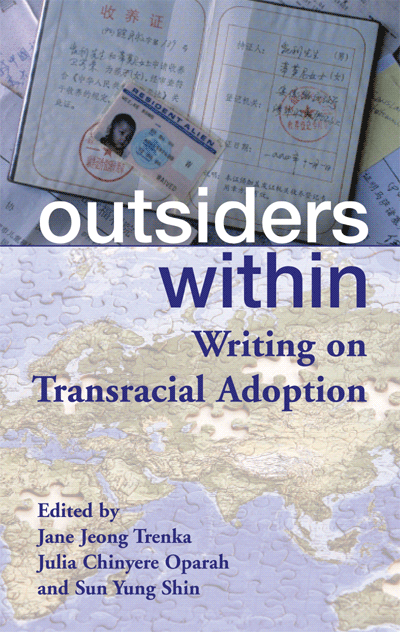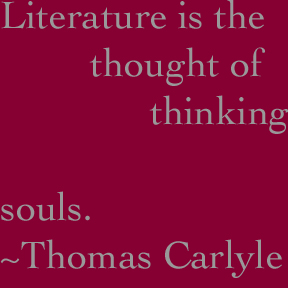Thinking Souls: Book Review: Outsiders Within
Juliana Hu Pegues reviews "Outsiders Within: Writing on Transracial Adoption," a book of diverse genres of writing by transracial adoptees that transmits the ambiguous and manyfold consequences of such lifechanging events.


Racism, poverty, colonialism, the “War on Drugs,” slavery, Indian boarding schools, economic globalization and import commodities. Sound like a book on adoption? These very issues engage our understanding in the compelling new anthology Outsiders Within: Writing on Transracial Adoption (South End Press, 2006). Editors Jane Jeong Trenka, Julia Chinyere Oparah, and Sun Yung Shin conceived this collection as a corrective to the “experts,” a challenge to the existing work on adoption largely written by white adoptive parents and those within the industry of adoption. Through this lens, transracial adoptees and their allies take in old landscapes and produce new essays, poems, and artwork.
Artists and communities often debate the relationship between art and politics; the desire to create meaningful expression is haunted by fears of didacticism. But this anthology offers us a dialogue rather than a screed. The poetry, fiction, and visual art are not an additive to the political essays; they ground the facts and footnotes in a visceral and collective experience. The works of these authors are meant to be read in conversation with each other.
Take, for example, Kim Park Nelson’s essay “Shopping for Children in the International Marketplace,” which looks at the commodification of transnational adoptees within economic globalization. We can feel the weight of response, the relationship of adoption and sweatshop, production and consumption, in Sun Yung Shin’s poem “Economic Miracles”:
Light reflects off my computer
monitor not the glittering
rice paddy, not the sewing
machine’s glittering
needle dipping like a cormorant into tomorrow’s
Nike shoe and this is
the Culture at work.
From physiognomy to economy, what
does any sky know
of impracticality? What does woman know
of miracles?
Neoconservative agendas supporting racism and poverty examined in Ellen M. Barry’s “Parents in Prison, Children in Crisis,” and Laura Brigg’s “Orphaning the Children of Welfare: ‘Crack Babies,’ Race, and Adoption Reform,” are powerfully answered by Kimberly R. Fardy’s voice in “The Finer Meaning”: “It is my perspective as a child born to a father in prison facing deportation and a teenage mother on welfare. It is my perspective as a person who was put into the system from birth and later adopted by white Americans to face the cruel world of a black-eyed pea in a bowl of rice.”
In her poem “If I Pull Away,” Shandra Spears confronts her loss, “I live within a myth about adoption / that conceals the truth of my birth / And I live within a myth about Indians / that conceals the truth of my future / and my past,” paralleling the conditions elaborated in Heidi Kiiwetinepinesiik Stark and Kekek Jason Todd Stark’s historiography of the Indian Child Welfare Act. The heartbreak in their essay is apparent in Spears’ achingly honest words, “In the story of my life, I am meant to be a pet, or a companion, / To fill in missing pieces in people’s lives, / To be a bandage over the wound in adoptive parents’ hearts.”
The enormity of dislocation underlying Tobias Hubinette’s “From Orphan Trains to Babylifts: Colonial Trafficking, Empire Building, and Social Engineering” is visually emphasized in Mihee-Nathalie Lemoine’s art piece 50 Numbers, which intersperses years, text, numbers of children adopted from Korea, and the faces of adoptees in a checkerboard pattern. This repeating theme of colonialism is encapsulated in Patrick McDermott’s “Disappeared Children and the Adoptee as Immigrant,” with “disappeared” serving as a powerful reality and metaphor for both Salvadoran children stolen by the military and the mental and emotional effects described by Beth Kyong Lo (“Korean Psych 101”), “To belong nowhere is to be invisible and to be invisible induces a deep rage.”
The writers in Outsiders Within bust the binary that transracial adoption either leaves damaged children or creates multicultural ambassadors. It’s just more complex. As these authors illustrate, adoptees are neither victims nor embodiments of a “colorblind” society. Jeni C. Wright tackles the absurdity of the latter stereotype in her creative prose: “What I had been told about race by my parents could be summed up in three words—Love Is Colorblind. My mom hand-stitched that ideal into the quilt hanging in my childhood bedroom. It is a beautiful ideal but one I had learned the limits of by first grade.”
The authors challenge us: are we not asking the right questions (if we are asking at all)? Instead of weighing in on the debate of whether or not Black children should be adopted by white parents, Dorothy Roberts chooses to ask, “Why are there so many children in foster care in the first place, and why are so many of them Black?” The editors question how the adoption conversation would change if we, “asked about the right of low-income parents to receive adequate economic support … the right of women with additions to receive treatment … the right of mothers in the global South and nations surviving the aftermath of war to food, housing, health care, and education for themselves and their children?”
While asking unflinching questions, this book is not a collection of answers. Starting from the loss expressed by longtime adoptee organizer John Raible– “I regret that adoption had to happen to us in the first place”– these writers insist on placing the adoption experience within a historic context. They also assert, however, the primacy of their own lives and viewpoints, never homogenous and sometimes contradictory. This is the powerful presence of the “outsider within.” In “Power of Periphery” author Kim Diehl reminds us, “I had to form an analysis about racism while being lovingly embraced by white people.”
Transracial adoption may be a story about loss, but is one of reclamation as well. This reclamation is not only an individual’s endeavor to make sense of one’s life, but also a journey of self-determination which includes the building of transracial adoptee networks, organizations, and communities. This collection self-consciously witnesses, giving voice to and for the transracial adoptee.
Outsiders Within is not an easy read, nor should it be. These authors dare to say that one has lived through, possibly even benefited from, a broken system. It will have an uncomfortable and meaningful impact on adoptive parents and those involved in the world of transracial adoption. As someone outside this world, as a mixed race writer with no children, Outsiders Within makes me rethink my own assumptions—about family, about nation, about race, about belonging. Ultimately, this anthology provides the breathtaking power of artful politics and the breathgiving possibility for change.